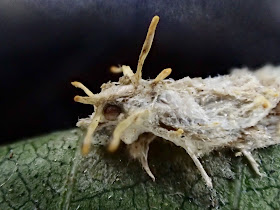I had these photographs of a moth with a bad hair day sent to me several years ago and just got around to identifying them. I have lost track of who sent them but the story was too good to pass.
 I had identified it as a fungus, Akanthomyces tuberculatus species complex on an unfortunate moth. My understanding was that the fungus parasitizes the host, eventually killing it, then acts as a saprobe, feeding on the corpse. When it is finished, it produces projections which are covered with asexual spores to find another victim. I sent it off to our staff mycologist. He takes the story over from here:
I had identified it as a fungus, Akanthomyces tuberculatus species complex on an unfortunate moth. My understanding was that the fungus parasitizes the host, eventually killing it, then acts as a saprobe, feeding on the corpse. When it is finished, it produces projections which are covered with asexual spores to find another victim. I sent it off to our staff mycologist. He takes the story over from here:
Mark Bower:
You are correct about what has happened to that poor moth. It came into contact with an Akanthomyces (tuberculatus or aculeateus, don’t know which one) spore. the spore stuck to the moth’s body, germinated, penetrated the body cavity, then devoured it from the inside. After the fungus was finished with its meal, it sent up spore-bearing structures as seen in your photo.

Pupa infested with Cordyceps militaris
There are over 1,000 known species of entomopathogenic fungi which parasitize or infect insects. Most of these fungi are capable of infecting multiple insect species, but some are species specific. Your example represents a pretty straight forward lethal infection, but it isn’t always this simple.
 |
| Bavaria bassiana which has killed a wasp |
 |
| O. unilateralis-Wikipedia |
The previous story is bizarre, but this type of fungal-insect interaction is actually fairly common. Male periodic locusts can be infected by a fungus which devour it from the inside, all the while producing chemicals which cause the males to be hypersexual, so they buzz around trying to mate with every locust (male or female) that moves. This behavior enhances spore dispersal. Also, some species of flies can be infected, causing them to land on the top of a plant (such as a blade of grass), raise their butts upwards and die. This position enhances spore dispersal.
 |
| Torrubiella arachnophila which has devoured a spider |
Editor's note:
Thanks to Mark Bower, I will now be worrying about a zombie fungus every time I climb to any heights.
